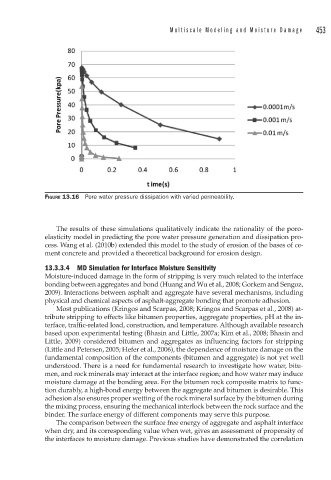Page 461 - Mechanics of Asphalt Microstructure and Micromechanics
P. 461
Multiscale Modeling and Moisture Damage 453
FIGURE 13.16 Pore water pressure dissipation with varied permeability.
The results of these simulations qualitatively indicate the rationality of the poro-
elasticity model in predicting the pore water pressure generation and dissipation pro-
cess. Wang et al. (2010b) extended this model to the study of erosion of the bases of ce-
ment concrete and provided a theoretical background for erosion design.
13.3.3.4 MD Simulation for Interface Moisture Sensitivity
Moisture-induced damage in the form of stripping is very much related to the interface
bonding between aggregates and bond (Huang and Wu et al., 2008; Gorkem and Sengoz,
2009). Interactions between asphalt and aggregate have several mechanisms, including
physical and chemical aspects of asphalt-aggregate bonding that promote adhesion.
Most publications (Kringos and Scarpas, 2008; Kringos and Scarpas et al., 2008) at-
tribute stripping to effects like bitumen properties, aggregate properties, pH at the in-
terface, traffic-related load, construction, and temperature. Although available research
based upon experimental testing (Bhasin and Little, 2007a; Kim et al., 2008; Bhasin and
Little, 2009) considered bitumen and aggregates as influencing factors for stripping
(Little and Petersen, 2005; Hefer et al., 2006), the dependence of moisture damage on the
fundamental composition of the components (bitumen and aggregate) is not yet well
understood. There is a need for fundamental research to investigate how water, bitu-
men, and rock minerals may interact at the interface region; and how water may induce
moisture damage at the bonding area. For the bitumen rock composite matrix to func-
tion durably, a high-bond energy between the aggregate and bitumen is desirable. This
adhesion also ensures proper wetting of the rock mineral surface by the bitumen during
the mixing process, ensuring the mechanical interlock between the rock surface and the
binder. The surface energy of different components may serve this purpose.
The comparison between the surface free energy of aggregate and asphalt interface
when dry, and its corresponding value when wet, gives an assessment of propensity of
the interfaces to moisture damage. Previous studies have demonstrated the correlation

